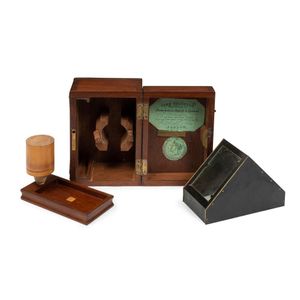1851 Crichton Mercury Trough Artificial Horizon
A cased mercury trough type artificial horizon by John Crichton, London, circa 1851, the mahogany box with brass hook and eye fasteners, metal and glass instrument, boxwood bottle with bone threaded funnel, label affixed inside lid reads 'John Crichton manufacture of Mathematical, Optical & nautical instruments; the the Honb: East India Company, & to the Honb: Corp.n of the Trinity house. 112 Leadenhall Street, London.' 'Great exhibition of 1851; prize medal for Sextants and drawing Instruments', the case 12.5 cm high, 19 cm wide, 14 cm deep
You must be a subscriber, and be logged in to view price and dealer details.
Subscribe Now to view actual auction price for this item
When you subscribe, you have the option of setting the currency in which to display prices to $Au, $US, $NZ or Stg.
This item has been sold, and the description, image and price are for reference purposes only.
- Boxwood - Boxwood is a hard, yellow coloured, close grained timber. In the 19th century it was often used for inlays, especially stringing, because of its contrasting colour to the darker timbers of the carcase. Stringing is the inlay of a narrow strip of veneer of a lighter colour, such as boxwood along or close to the edges of an object that has been veneered in a darker timber such as mahogany.
Because of its fine grain and resistnce to splitting or chipping it has also been used for treen, turnings, carvings and other small wooden items, such as chess pieces. - East India Company - The British East India Company was a British trading company that was active from 1600 to 1858. It was one of the leading commercial enterprises of its time and played a key role in the development of British trade and commerce with India, China, and Southeast Asia.
The British East India Company was granted a monopoly on trade with the East Indies by the English government, and it quickly established a network of trading posts and settlements throughout India and Southeast Asia. The company was involved in numerous wars and conflicts in India and Southeast Asia, and it gradually gained political influence over large parts of the region.In addition to its commercial activities, the British East India Company was also involved in the spread of British culture and influence in the regions it traded with. The company played a significant role in the introduction of British goods, ideas, and institutions in India and Southeast Asia, and it was instrumental in the establishment of the British Empire in India.The British East India Company was dissolved in 1858, following the Indian Rebellion of 1857.
The Dutch East India Company, also known as the Vereenigde Oost-Indische Compagnie (VOC), was a Dutch trading company that was active from 1602 to 1798. It was one of the first multinational corporations in the world and one of the largest commercial enterprises in history.
The Dutch East India Company was established with the goal of establishing a trade monopoly in the spice trade with the East Indies. The company was granted a 21-year monopoly on the Dutch spice trade, and it quickly became one of the most successful and powerful trading companies in the world.
Over the course of the 17th and 18th centuries, the Dutch East India Company expanded its reach and influence throughout Southeast Asia, the Indian subcontinent, and the Far East. The company established a network of trading posts and colonies, and it played a major role in the commercial and political development of many regions in Asia.
Despite its commercial success, the Dutch East India Company was also notorious for its ruthless treatment of local populations and its exploitation of resources. The company was involved in numerous conflicts and wars throughout its history, and it was accused of using slave labor and engaging in acts of piracy.
The Dutch East India Company was dissolved in 1798. - Circa - A Latin term meaning 'about', often used in the antique trade to give an approximate date for the piece, usually considered to be five years on either side of the circa year. Thus, circa 1900 means the piece was made about 1900, probably between 1895 and 1905. The expression is sometimes abbreviated to c.1900.
- Mahogany - Mahogany is a dense, close grained red-coloured timber from the West Indies and Central America. It was first imported into Europe in the the early 18th century and its use continued through the 19th century. It was popular for furniture making because of its strength, the wide boards available, the distinctive grain on some boards, termed flame mahogany and the rich warm colour of the timber when it was polished.. The "flame" was produced where a limb grew out from the trunk of the tree, and this timber was usually sliced into veneers for feature panels on doors, backs and cornices.
Some terms used to describe mahogany relate to the country from which it originally came, such as "Cuban" mahogany, "Honduras" mahogany etc. However unless the wood has been tested the names assigned are more a selling feature, rather than a true indication of the timber's origin.
This item has been included into following indexes:
